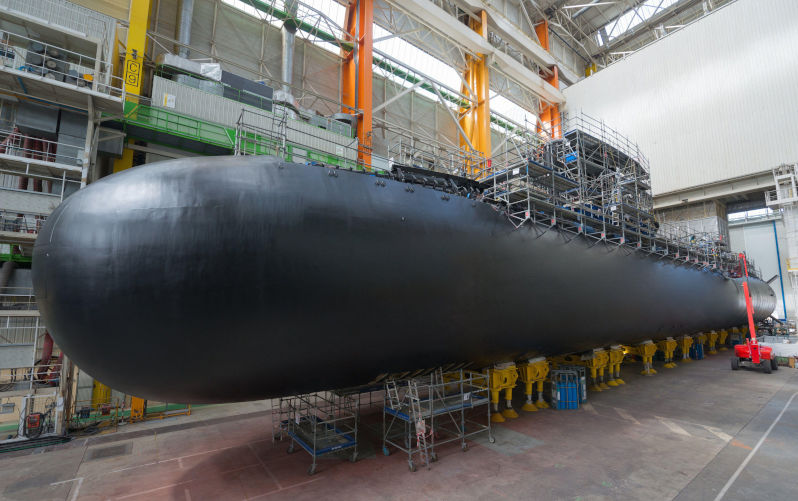AUKUS on track? No, Australia needs Plan B now
April 9, 2025
Last Monday’s AUKUS Security forum at the National Press Club heard arguments of those seeking to support the status quo. It was argued that criticism undermines AUKUS and risks turning the possibility that the US will not be able to spare Virginia class SSNs for sale to Australia from an ‘if’ to certainty.
We should be giving 110% to AUKUS, not discussing Plan B. The French Suffren does not have the legs. Finally, we are on track with mitigation measures in place. Let me consider each in turn.
The reality and not the fantasy of the US submarine building situation needs to be accepted. It is not disloyal or inappropriate to point out the consequences for Australia, as seems to be implied. It cannot be ignored in the hope that it will all be OK on the day in 2031 when the next US administration has to make a decision on whether to sell Australia the first of three to five Virginia class submarines.
The shipbuilding situation is well set out in the latest Congressional Budget Office Analysis of the Navy’s 2025 Shipbuilding Plan released in January 2025.
- The US has been trying to deliver two, 7800 ton Virginia class nuclear attack submarines per year.
- Due to workforce issues in the two building yards and the supply chain, they have only achieved 1.2 per year over the last fie years, leading to a backlog of partly built submarines in the shipyards.
- The target is changing, the US has started building three of a total of 12 larger versions of the Virginia and has an additional requirement, to deliver one, very large, Columbia class nuclear powered ballistic missile submarine per year from 2029. Twelve Columbias are intended.
- This requirement has significantly increased the shipyards’ target; at least thrice the current effort.
- The AUKUS plan is based on the shipyards further lifting Virginia production to 2.33 per year from 2030, providing a replacement for the three Virginias to be sold to Australia.
- The Budget Office report provides an illustrative scenario, demonstrating that even under this ideal (and highly unlikely) scenario, the USN would lose 40 SSN years in the period 2030 to 2060.
- If no additional output is achieved and five Virginias are needed to be sold to cover the gap until SSN-AUKUS arrives, the CBO Report advises that this loss would increase to 102 years.
- The US Navy’s number of attack submarines is dropping as the predecessors to the Virginia, the Los Angeles class retire, faster than replacements can be built. The Report notes that in 2028 the USN will have 47 of the required 66 attack submarines. I have argued that the numbers will be less than this.
In January this year, both shipyards reported difficulties in retaining new employees, with attrition rates of 50% to 60% among first-year trainees and a cost increase of 21%, driven mainly by wages growth to attract employees. The shortfall in attack submarine numbers, difficulties in achieving increased production to achieve the much-increased target and the impact of selling Virginias, regardless of the production rate, sets the scene for the president of the day in 2031.
It is a reasonable prediction to suggest that the US president of the day in 2031 is highly unlikely to certify that the sale of Virginia class submarines to Australia will not “degrade” the US’ underwater warfare capability – as required by legislation covering the sale.
The probability of this occurring is not affected by discussing it. The probability of it occurring is now so high that we must consider how to mitigate its impact. Hope or denial is not a valid strategy.
As to 110% effort on current preparations, I agree. The training and preparations for maintenance of nuclear submarines in Western Australia and their building in Adelaide should continue with full commitment. We are going to need these personnel, skills and facilities to transition, build and operate nuclear-powered, sovereign Australian submarines.
These preparations may be on track. But, a critical component of the plan, the sale of three to five Virginia class submarines to Australia is well off track and highly unlikely to recover.
Further, the current plan is flawed. Australia needs to select the right design — only one design, this will be challenging enough — not three differing submarines. It must be one which we can build in Adelaide and own in sufficient numbers to make a strategic impact in our defence. This is discussed in my earlier article, Instead of wasting time on the flawed AUKUS submarine program, we must go to plan B now, 11 March 2025.
Why bother? The critical and unique value of submarines and the much higher effectiveness and survivability of nuclear-powered submarines justifies the expense and trouble. B-21 bombers or missiles do not replace the capability offered by submarines.
There could be a number of options for Plan B, including conventionally powered submarines, to no submarines at all. We should assess them all and avoid wasting further funds on the current, flawed plan. Is my suggested Plan B — the French Suffren — a valid solution? We will not know unless we ask the question.
I do know that blind commitment to a flawed plan, heading for the wrong destination, is not going deliver a valid, sovereign solution, no matter how well the preparatory measures may be going.
It is high time the government and the Defence Department considered these realities and determined a way ahead to avoid them.
Australia’s submarine capability could depend on it.
